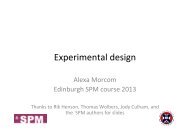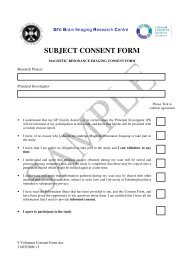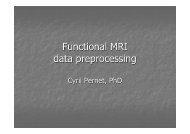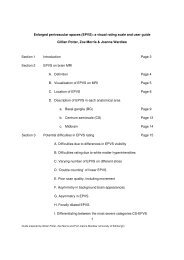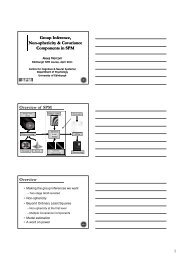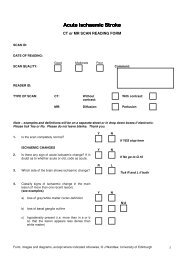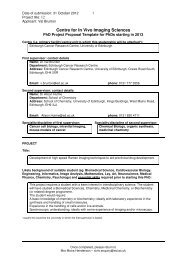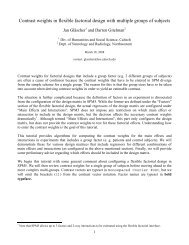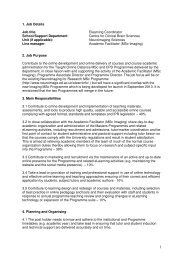Covariance components
Covariance components
Covariance components
Create successful ePaper yourself
Turn your PDF publications into a flip-book with our unique Google optimized e-Paper software.
Edinburgh course – Avril 2010<br />
Linear Models – Contrasts – Variance <strong>components</strong><br />
Jean-Baptiste Poline<br />
Neurospin, I2BM, CEA Saclay, France<br />
Credits: Will Penny, G. Flandin, SPM course authors
Outline<br />
• Part I: Linear model and contrast: going<br />
through it again and going further<br />
• Part II: Variance component and group<br />
analyses*<br />
* (shamelessly(<br />
stolen from Will Penny SPM course)
images<br />
Spatial filter<br />
Design<br />
matrix<br />
Adjusted data<br />
Your question:<br />
a contrast<br />
realignment &<br />
coregistration<br />
smoothing<br />
General Linear Model<br />
Linear fit<br />
statistical image<br />
Random Field<br />
Theory<br />
normalisation<br />
Anatomical<br />
Reference<br />
Statistical Map<br />
Uncorrected p-values<br />
Corrected p-values
Plan<br />
• REPEAT: model and fitting the data with a Linear Model<br />
• Make sure we understand the testing procedures : t-t<br />
and F-testsF<br />
• But what do we test exactly ?<br />
• Examples – almost real
One voxel = One test (t, F, ...)<br />
amplitude<br />
General Linear Model<br />
fitting<br />
statistical image<br />
time<br />
Temporal series<br />
fMRI<br />
voxel time course<br />
Statistical image<br />
(SPM)
Regression example…<br />
90 100 110<br />
-10 0 10<br />
90 100 110<br />
-2 0 2<br />
= β 1<br />
+ β 2 +<br />
β 1 = 1 β 2 = 1<br />
Fit the GLM<br />
voxel time series<br />
box-car reference function<br />
Mean value
Regression example…<br />
90 100 110<br />
-2 0 2<br />
0 1 2<br />
-2 0 2<br />
= + +<br />
β 1<br />
β 2<br />
β 1 = 5 β 2 = 100<br />
Fit the GLM<br />
voxel time series<br />
box-car reference function<br />
Mean value
…revisited : matrix form<br />
= β 1 + +<br />
β 2<br />
Y = × f(t) + × +<br />
β 1 β 2 1<br />
ε
Box car regression: design matrix…<br />
data vector<br />
(voxel time series)<br />
design matrix<br />
parameters<br />
error vector<br />
α<br />
β 1<br />
= × +<br />
µ<br />
β 2<br />
Y = X × β +<br />
ε
Fact: model parameters depend on<br />
regressors scaling<br />
Q: When do I care ?<br />
A: ONLY when comparing manually<br />
entered regressors (say you would like to<br />
compare two scores)<br />
What if two conditions A and B are not of<br />
the same duration before convolution HRF?
What if we believe that there are drifts?
Add more reference functions / covariates ...<br />
Discrete cosine transform basis functions
…design matrix<br />
data vector<br />
β 1 β 2 β 3<br />
β … 4<br />
error vector<br />
=<br />
+<br />
Y<br />
= X × β +<br />
ε
error vector<br />
ε<br />
…design matrix<br />
data vector<br />
design matrix<br />
parameters<br />
= the betas (here : 1 to 9)<br />
β α 1<br />
β µ 2<br />
β 3<br />
=<br />
β 4<br />
β 5<br />
+<br />
β 6<br />
β 9<br />
β 7<br />
β 8<br />
Y = X × β +
Fitting the model = finding some estimate of the<br />
betas<br />
raw fMRI time series<br />
adjusted for low Hz effects<br />
Raw data<br />
fitted signal<br />
fitted low frequencies<br />
fitted drift<br />
residuals<br />
How do we find the betas estimates? By<br />
minimizing the residual variance
Fitting the model = finding some estimate of the betas<br />
β 1<br />
=<br />
β 2<br />
β 5<br />
β 6<br />
+<br />
Y = X β + ε<br />
β 7<br />
...<br />
finding the betas = minimising the sum of square of the residuals<br />
∥Y−X ∥ 2 = Σ i [ y i −X <br />
i ] 2<br />
when β are estimated: let’s s call them b<br />
when ε is estimated : let’s s call it e<br />
estimated SD of ε : let’s s call it s
Take home ...<br />
• We put in our model regressors (or covariates) that represent<br />
how we think the signal is varying (of interest and of no interest<br />
alike)<br />
• WHICH ONE TO INCLUDE ?<br />
• What if we have too many?<br />
• Coefficients (= parameters) are estimated by minimizing the<br />
fluctuations, - variability – variance – of estimated noise – the<br />
residuals.<br />
• Because the parameters depend on the scaling of the regressors<br />
included in the model, one should be careful in comparing<br />
manually entered regressors, or conditions of different durations
Plan<br />
• Make sure we all know about the estimation (fitting) part ....<br />
• Make sure we understand t and F tests<br />
• But what do we test exactly ?<br />
• An example – almost real
T test - one dimensional contrasts - SPM{t}<br />
c’ = 1 0 0 0 0 0 0 0<br />
b 1 b 2 b 3 b 4 b 5 ....<br />
A contrast = a weighted sum of parameters: c´ × b<br />
b 1 > 0 ?<br />
Compute 1xb 1 + 0xb 2 + 0xb 3 + 0xb 4 + 0xb 5 + . . .<br />
divide by estimated standard deviation of b 1<br />
T =<br />
contrast of<br />
estimated<br />
parameters<br />
variance<br />
estimate<br />
T =<br />
c’b<br />
s 2 c’(X’X)<br />
X) - c<br />
SPM{t}
From one time series to an image<br />
voxels<br />
Y: data<br />
=<br />
X *<br />
B<br />
beta??? images<br />
+<br />
E<br />
scans<br />
Var(E) = s 2<br />
spm_ResMS<br />
c’ = 1 0 0 0 0 0 0 0<br />
T =<br />
c’b<br />
s 2 c’(X’X)<br />
X) - c<br />
=<br />
spm_con??? images<br />
spm_t??? images
F-test : a reduced model<br />
H 0 : β 1 = 0<br />
H 0 : True model is X 0<br />
X 0<br />
c’ = 1 0 0 0 0 0 0 0<br />
X 1<br />
X 0<br />
F ~ ( S 0<br />
2<br />
-S 2 ) / S 2<br />
T values become<br />
F values. F = T 2<br />
S 2 S 0<br />
2<br />
This (full) model ? Or this one?<br />
Both “activation”<br />
and<br />
“deactivations”<br />
are tested. Voxel<br />
wise p-values are<br />
halved.
F-test : a reduced model or ...<br />
Tests multiple linear hypotheses : Does X1 model anything ?<br />
H 0 : True (reduced) model is X 0<br />
X 0 X 1<br />
X 0<br />
S 2 S<br />
2<br />
0<br />
F =<br />
Or this one?<br />
additional<br />
variance<br />
accounted for<br />
by tested effects<br />
error<br />
variance<br />
estimate<br />
This (full) model ?<br />
F ~ ( S 0<br />
2<br />
-S 2 ) / S 2
F-test : a reduced model or ... multi-dimensional<br />
contrasts ?<br />
tests multiple linear hypotheses. Ex : does drift functions model anything?<br />
H 0 : True model is X 0<br />
X 0<br />
H 0 : β 3-9 = (0 0 0 0 ...)<br />
X 0<br />
X 1<br />
0 0 1 0 0 0 0 0<br />
0 0 0 1 0 0 0 0<br />
0 0 0 0 1 0 0 0<br />
c’ =<br />
0 0 0 0 0 1 0 0<br />
0 0 0 0 0 0 1 0<br />
0 0 0 0 0 0 0 1<br />
This (full) model ? Or this one?
Convolution<br />
model<br />
Design and<br />
contrast<br />
SPM(t) or<br />
SPM(F)<br />
Fitted and<br />
adjusted data
T and F test: take home ...<br />
• T tests are simple combinations of the betas; they are either<br />
positive or negative (b1 – b2 is different from b2 – b1)<br />
• F tests can be viewed as testing for the additional variance<br />
explained by a larger model wrt a simpler model, or<br />
• F tests the sum of the squares of one or several combinations of o<br />
the betas<br />
• in testing “single contrast” with an F test, for ex. b1 – b2, the<br />
result will be the same as testing b2 – b1. It will be exactly the<br />
square of the t-test, t test, testing for both positive and negative effects.
Plan<br />
• Make sure we all know about the estimation (fitting) part ....<br />
• Make sure we understand t and F tests<br />
• But what do we test exactly ? Correlation between regressors<br />
• An example – almost real
« Additional variance » : Again<br />
No correlation between green<br />
red and yellow
Testing for the green<br />
correlated regressors, for example<br />
green: subject age<br />
yellow: subject score
Testing for the red<br />
correlated contrasts
Testing for the green<br />
Very correlated regressors ?<br />
Dangerous !
Testing for the green and yellow<br />
If significant ? Could be G or Y !
Testing for the green<br />
Completely correlated<br />
regressors ?<br />
Impossible to test ! (not<br />
estimable)
An example: : real<br />
Testing for first regressor: T max = 9.8
Including the movement parameters in the<br />
model<br />
Testing for first regressor: activation is gone !
Implicit or explicit (⊥) decorrelation (or<br />
orthogonalisation)<br />
Y<br />
e<br />
Xb<br />
C2<br />
Xb<br />
Space of X<br />
C2 ⊥<br />
C2<br />
C1<br />
L C1<br />
⊥<br />
C1<br />
L C2<br />
This generalises when testing<br />
several regressors (F tests)<br />
cf Andrade et al., NeuroImage, 1999<br />
L C2 :<br />
L C1<br />
⊥<br />
:<br />
test of C2 in the<br />
implicit ⊥ model<br />
test of C1 in the<br />
explicit ⊥ model
Correlation between regressors: take<br />
home ...<br />
• Do we care about correlation in the design ?<br />
Yes, always<br />
• Start with the experimental design : conditions<br />
should be as uncorrelated as possible<br />
• use F tests to test for the overall variance<br />
explained by several (correlated) regressors
Plan<br />
• Make sure we all know about the estimation (fitting) part ....<br />
• Make sure we understand t and F tests<br />
• But what do we test exactly ? Correlation between regressors<br />
• An example – almost real
A real example (almost !)<br />
Experimental Design<br />
Design Matrix<br />
Factorial design with 2 factors : modality and category<br />
2 levels for modality (eg Visual/Auditory)<br />
3 levels for category (eg 3 categories of words)<br />
V<br />
A<br />
C1<br />
C2<br />
C3<br />
C1<br />
C2<br />
C3<br />
V A C 1<br />
C 2<br />
C 3
Asking ourselves some questions ...<br />
V A C 1<br />
C 2<br />
C 3<br />
Test C1 > C2 : c = [ 0 0 1 -1 0 0 ]<br />
Test V > A : c = [ 1 -1 0 0 0 0 ]<br />
[ 0 0 1 0 0 0 ]<br />
Test C1,C2,C3 ? (F) c = [ 0 0 0 1 0 0 ]<br />
[ 0 0 0 0 1 0 ]<br />
Test the interaction MxC ?<br />
• Design Matrix not orthogonal<br />
• Many contrasts are non estimable<br />
• Interactions MxC are not modelled
Modelling the interactions
Test C1 > C2 : c = [ 1 1 -1 -1 0 0 0]<br />
C 1 C 1 C 2 C 2 C 3 C 3<br />
Test V > A : c = [ 1 -1 1 -1 1 -1 0]<br />
V A V A V A<br />
Test the category effect :<br />
[ 1 1 -1 -1 0 0 0]<br />
c = [ 0 0 1 1 -1 -1 0]<br />
[ 1 1 0 0 -1 -1 0]<br />
Test the interaction MxC :<br />
[ 1 -1 -1 1 0 0 0]<br />
c = [ 0 0 1 -1 -1 1 0]<br />
[ 1 -1 0 0 -1 1 0]<br />
• Design Matrix orthogonal<br />
• All contrasts are estimable<br />
• Interactions MxC modelled<br />
• If no interaction ... ? Model is too “big” !
With a more flexible model<br />
C 1<br />
C 1<br />
C 2<br />
C 2<br />
C 3<br />
C 3<br />
V A V A V A<br />
Test C1 > C2 ?<br />
Test C1 different from C2 ?<br />
from<br />
c = [ 1 1 -1 -1 0 0 0]<br />
to<br />
c = [ 1 0 1 0 -1 0 -1 0 0 0 0 0 0]<br />
[ 0 1 0 1 0 -1 0 -1 0 0 0 0 0]<br />
becomes an F test!<br />
What if we use only:<br />
c = [ 1 0 1 0 -1 0 -1 0 0 0 0 0 0]<br />
OK only if the regressors coding for the delay are all<br />
equal
Toy example: take home ...<br />
• use F tests when<br />
- Test for >0 and
1<br />
General Linear Model<br />
p<br />
1 1<br />
y<br />
= Xθ + ε<br />
θ<br />
y<br />
=<br />
X<br />
p<br />
+<br />
ε<br />
Error <strong>Covariance</strong><br />
N<br />
N<br />
N<br />
C ε<br />
= ∑λ<br />
k<br />
k<br />
Q<br />
k<br />
N: N: number number of of scans scans<br />
p: p: number number of of regressors<br />
Model is is specified by by<br />
1. 1. Design matrix X<br />
2. 2. Assumptions about εε
Estimation<br />
y = X θ + ε<br />
N × 1 N × p p×<br />
1 N × 1<br />
1. 1. ReML-algorithm<br />
C<br />
ε<br />
∑<br />
= λkQ<br />
k<br />
k<br />
Maximise L = ln p(y | λ) = ln ∫ p(y| θ , λ)<br />
dθ<br />
L<br />
g<br />
λ<br />
dL<br />
g =<br />
dλ<br />
2<br />
d L<br />
J =<br />
2<br />
dλ<br />
λ = λ + J<br />
−1<br />
g<br />
2. 2. Weighted Least Squares<br />
θ = ( X C X ) X C y<br />
T −1 T T −1<br />
e<br />
e<br />
Friston Fristonet et al. al. 2002, 2002,<br />
Neuroimage
Hierarchical model<br />
θ<br />
Hierarchical model<br />
θ<br />
y<br />
(1)<br />
( n−1)<br />
=<br />
=<br />
=<br />
X<br />
X<br />
X<br />
(1)<br />
(2)<br />
( n)<br />
θ<br />
θ<br />
M<br />
θ<br />
(1)<br />
(2)<br />
( n)<br />
+ ε<br />
+ ε<br />
+ ε<br />
(1)<br />
(2)<br />
( n)<br />
Multiple variance <strong>components</strong><br />
at at each level<br />
C<br />
( i )<br />
=<br />
( i )<br />
∑λ<br />
Q<br />
( i )<br />
ε<br />
k k<br />
k<br />
At At each level, distribution of of parameters<br />
is is given by by level above.<br />
What we we don’t know: distribution of of<br />
parameters and variance parameters.
θ<br />
y<br />
Example: Two level model<br />
=<br />
() 1 () 1 ( 1)<br />
θ<br />
( 1) ( 2 ) ( 2 ) ( 2 )<br />
=<br />
X<br />
X<br />
θ<br />
+<br />
+<br />
ε<br />
ε<br />
y<br />
=<br />
(1)<br />
X 1<br />
(1)<br />
X 2<br />
( 1)<br />
θ<br />
+<br />
( 1 )<br />
( 1)<br />
ε<br />
θ = X<br />
( 2)<br />
( 2 )<br />
θ<br />
+ ε<br />
( 2)<br />
(1)<br />
X 3<br />
First level<br />
Second level
Estimation<br />
Hierarchical<br />
model<br />
θ<br />
y<br />
(1)<br />
=<br />
=<br />
X<br />
X<br />
(1)<br />
(2)<br />
θ<br />
θ<br />
M<br />
(1)<br />
(2)<br />
+ ε<br />
+ ε<br />
(1)<br />
(2)<br />
θ<br />
( n−1)<br />
=<br />
X<br />
( n)<br />
θ<br />
( n)<br />
+ ε<br />
( n)<br />
Single-level<br />
model<br />
y<br />
(1) (1) (2)<br />
= ε + X ε +<br />
X<br />
... +<br />
X<br />
(1) ( n−1) ( n)<br />
X<br />
K<br />
K X<br />
(1) ( n) ( n)<br />
= Xθ<br />
+ e<br />
ε<br />
θ<br />
+
Group analysis in practice<br />
Many 2-level models are just too big to to<br />
compute.<br />
And even if, if, it it takes a long time!<br />
Is Is there a fast approximation?
Summary Statistics approach<br />
First level<br />
Second level<br />
T<br />
Data Design Matrix Contrast Images Var(<br />
c α )<br />
t =<br />
c<br />
ˆ<br />
T<br />
ˆ α<br />
ˆ<br />
αˆ1<br />
2<br />
σˆ1<br />
SPM(t)<br />
αˆ2<br />
2<br />
σˆ<br />
2<br />
αˆ11<br />
2<br />
σˆ11<br />
αˆ12<br />
2<br />
σˆ12<br />
One-sample<br />
t-test @ 2 nd nd level
Validity of approach<br />
The summary stats approach is is exact if if for for each<br />
session/subject:<br />
Within-session covariance the the same<br />
First-level design the the same<br />
All other cases: Summary stats approach seems to to be be<br />
robust against typical violations.
Auditory Data<br />
Summary<br />
statistics<br />
Hierarchical<br />
Model<br />
Friston Fristonet et al. al. (2004) (2004) Mixed Mixed<br />
effects effects and and fMRI fMRI studies, studies,<br />
Neuroimage Neuroimage
Multiple contrasts per subject<br />
Stimuli:<br />
Auditory Presentation (SOA = 4 secs) secs) of of words<br />
Motion<br />
Sound<br />
Visual<br />
Action<br />
“jump”<br />
“click”<br />
“pink”<br />
“turn”<br />
Subjects:<br />
Scanning:<br />
Question:<br />
(i) (i) 12 12 control subjects<br />
fMRI, 250 250 scans per per<br />
subject, block design<br />
What regions are are affected<br />
by by the the semantic content of of<br />
the the words?<br />
U. U. Noppeney et et al. al.
ANOVA<br />
1 st st level:<br />
1.Motion<br />
2.Sound<br />
3.Visual<br />
4.Action<br />
?<br />
=<br />
?<br />
=<br />
X<br />
?<br />
=<br />
2 nd nd level:<br />
2,1 3,1<br />
4,1<br />
3,2<br />
4,2<br />
4,3
ANOVA<br />
1 st st level:<br />
Motion<br />
Sound<br />
Visual<br />
Action<br />
?<br />
=<br />
?<br />
=<br />
X<br />
?<br />
=<br />
2 nd nd level:<br />
T<br />
c<br />
=<br />
⎛ 1<br />
⎜<br />
⎜ 0<br />
⎜<br />
⎝ 0<br />
−1<br />
1<br />
0<br />
0<br />
−1<br />
1<br />
0 ⎞<br />
⎟<br />
0 ⎟<br />
−1⎟<br />
⎠<br />
V<br />
X
Summary<br />
Linear hierarchical models are are general enough for for typical multisubject<br />
imaging data (PET, fMRI, EEG/MEG).<br />
Summary statistics are are robust approximation for for group analysis.<br />
Also accomodates multiple contrasts per subject.
Thank you for your attention!<br />
jbpoline@cea.fr



